Google Analytics 4 (GA4) is a powerful tool for tracking user interactions, but setting up key events—also known as conversions—correctly is crucial for making data-driven decisions. If you're tracking purchases, lead form submissions, or newsletter sign-ups, make sure to configure conversions to ensure that your analytics reflect real business performance. Many businesses make costly mistakes when setting up key events in GA4, leading to inaccurate data, misattributed conversions, and poor marketing decisions. A missing or improperly configured conversion can mean the difference between optimizing your ad spend effectively or wasting valuable budget on campaigns that aren’t driving results.
In this guide, we’ll walk you through the process of setting up key events in GA4 step by step. We’ll also highlight common pitfalls to avoid, ensuring that your tracking is accurate, reliable, and aligned with your business goals. By the end, you'll have a solid understanding of how to track conversions correctly—so you can make smarter marketing decisions and maximize your ROI.
How to Identify Key Events on Your Website
While GA4 automatically tracks many events by default, some critical interactions may not be captured. In such cases, you need to designate and implement key events to ensure they are properly tracked.

Common examples of key events in GA4 include:
- Purchases – When a user completes a transaction on your site.
- Sign-ups – When someone creates an account or subscribes to a service.
- Form submissions – When a visitor fills out and submits a contact or inquiry form.
- Add to cart – When a user adds a product to their shopping cart.
- Video engagement – When users watch a certain percentage of a video.
- Scroll depth – When a visitor scrolls down to a specific portion of a webpage.
Identifying key events depends on your business goals and what you consider valuable to track on your website. There are no strict limitations—anything you deem important, even a simple call-to-action button, can be tracked. In the next section, we’ll cover how to set up key events.
How to Plan Your Conversion
Let’s assume you’ve already identified your key events—great! While the next steps are optional, they can provide valuable insights and ensure a more strategic approach to event tracking. Here are some of the things you can consider doing before fully jumping into the implementation.
- Understanding Primary vs. Secondary Conversions –
- Distinguish between essential business-driving actions and supporting interactions. Primary events are those that are top priority, while secondary events are important but won’t significantly impact your data analysis if not implemented.
- Setting Measurable Goals and Defining Success Criteria –
- Establishing clear metrics to evaluate performance effectively.
- Documenting Conversion Events Before Implementation (Spreadsheet Approach) – Organizing and structuring key event tracking for future reference. Here’s an example of what we compiled for the Analytics Mates GTM audit.
How to Implement Key Events via Google Tag Manager
GTM Account Setup and Sample Variable Data Identification
Okay, so now that we have a better understanding of why we need to focus on this, especially if you are new in GA4 tracking - we’ll go straight ahead to the steps. In this example we'll be setting an event tracking for the CTA button on our Analytics Mates website called “BOOK A FREE CONSULTATION”.

I’m assuming that you already have an idea on how to create a GTM Account and Container. Also, how to install GTM on your website. If not, then you can check GTM’s documentation on this matter. We’ll be working on making a more compelling guide in the future. Once everything is set up, access your GTM account.
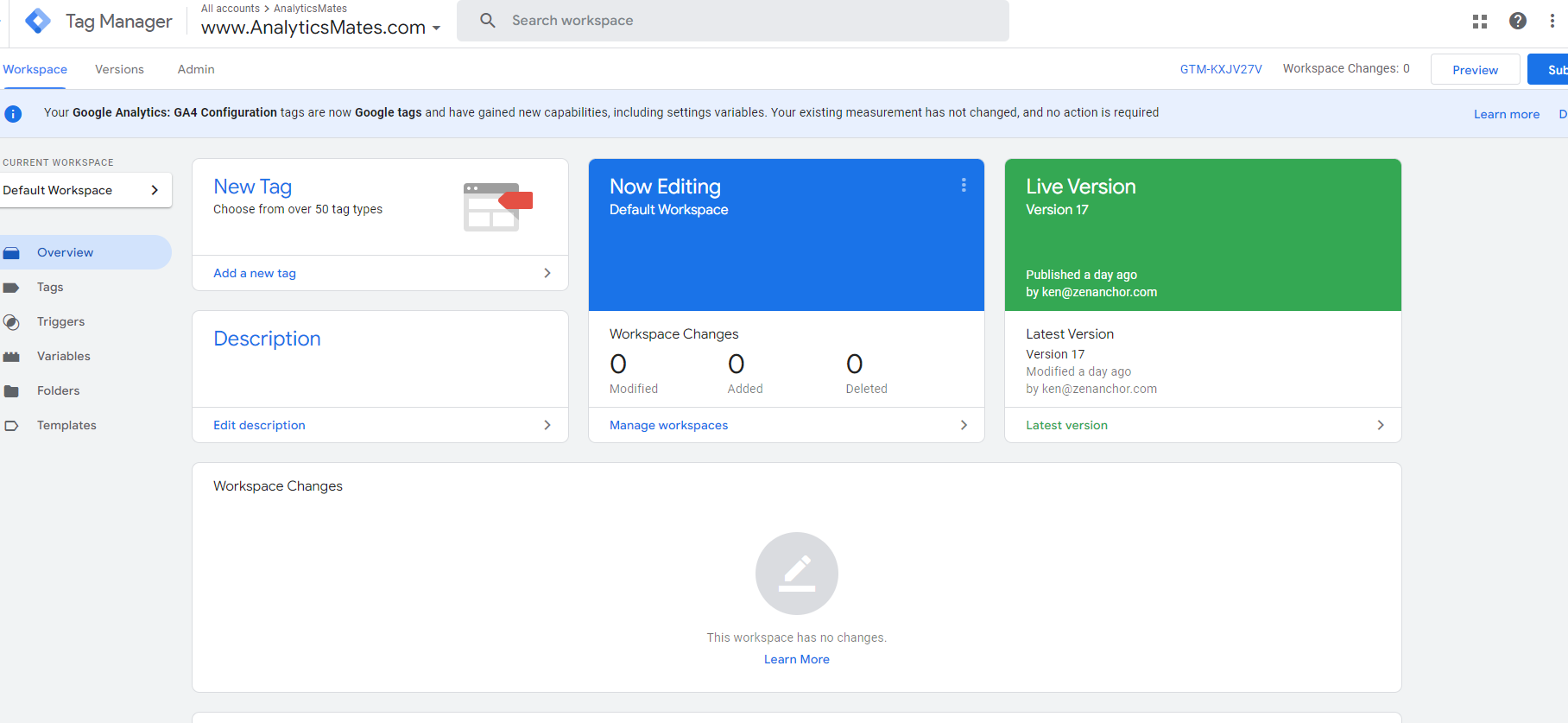
1. On the top right corner of the page, click “Preview”.

2. Enter your website address, in this example it’s “https://www.analyticsmates.com/” and click Connect
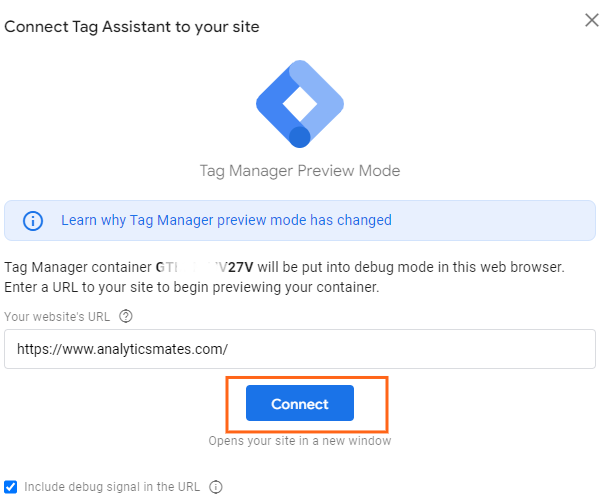
3. On the Tagassistant page you’ll be presented with this page:
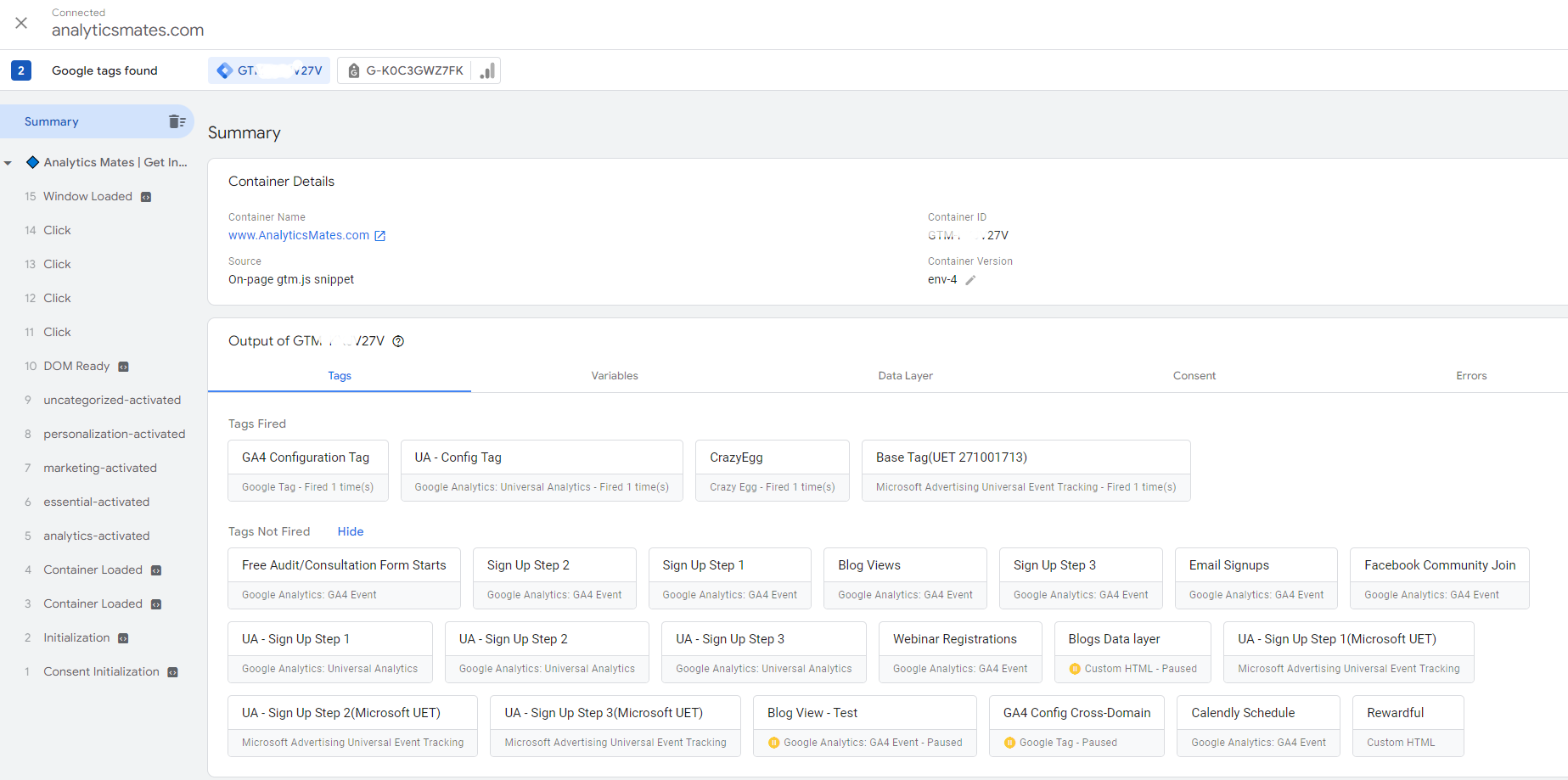
It shows all recent event tags at the bottom of the page. Left section shows user interaction from the website. If a user clicks on a particular link or button on the page, that interaction will appear in the left section.
Our Goal here is to get the website element that we can use to create an event tag in GTM. In this case we are going to track the CTA called “BOOK A FREE CONSULTATION”.
4. So on the debug page, just click on the CTA (button or link) that you want to track.
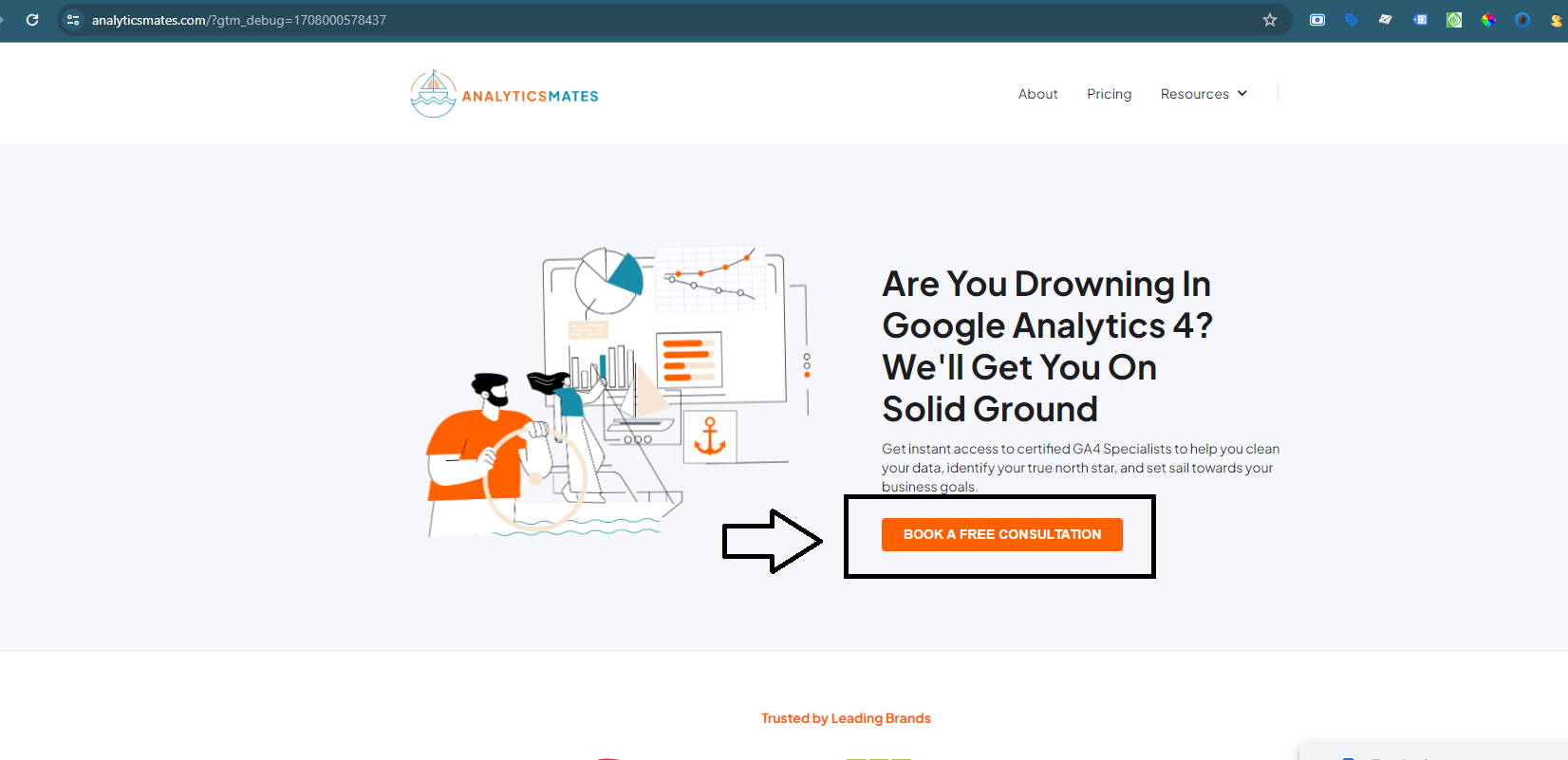
5. Once you clicked, go back to the tagassistant page and find the user interaction that corresponds to the clicked you made. In this example, it’s the “Click” button.
6. Now to get the variables for this CTA, click on the “Variables” tab. Now we need to get the variable value that we can use once we create an event tag in GTM. Here, we’re going to use the Click Text variable with the value “BOOK A FREE CONSULTATION”.

Actual GA4 GTM Event Tracking Creation
Now that we have the information that we need, the next step focuses on the actual tag implementation.
1. Go back to your GTM Account / workspace.
2. Under Tags, click New.

3. On the Tag creation page, give your tag a name
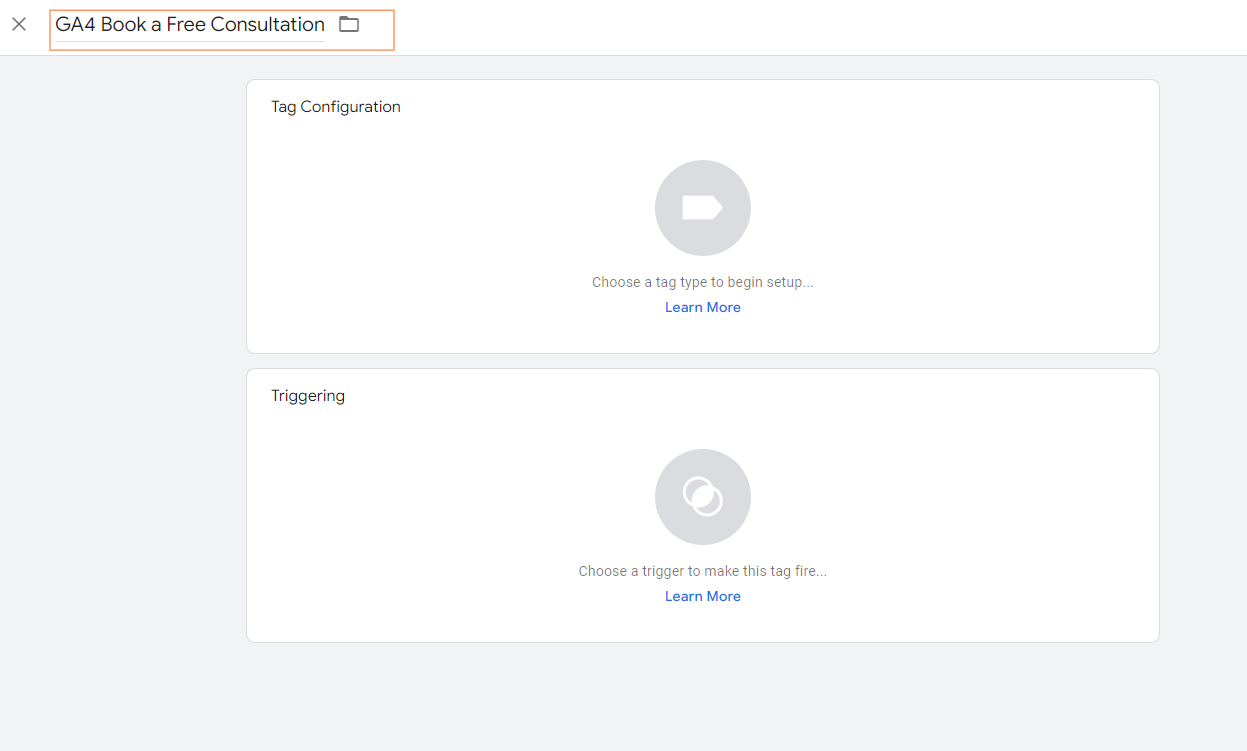
4. Click Tag Configuration > Google Analytics > Google Analytics: GA4 Event

5. Type in your GA4 Measurement ID and the event name that you want to pass onto your GA4. In this example, we’re naming the event “Book a Free Consultation”.
6. Click the bottom section called “Triggering” so we can set up a trigger that will fire the event once a user interacts with your CTA.
7. Under Choose a trigger page, click the “+” icon on the top right corner of the page.
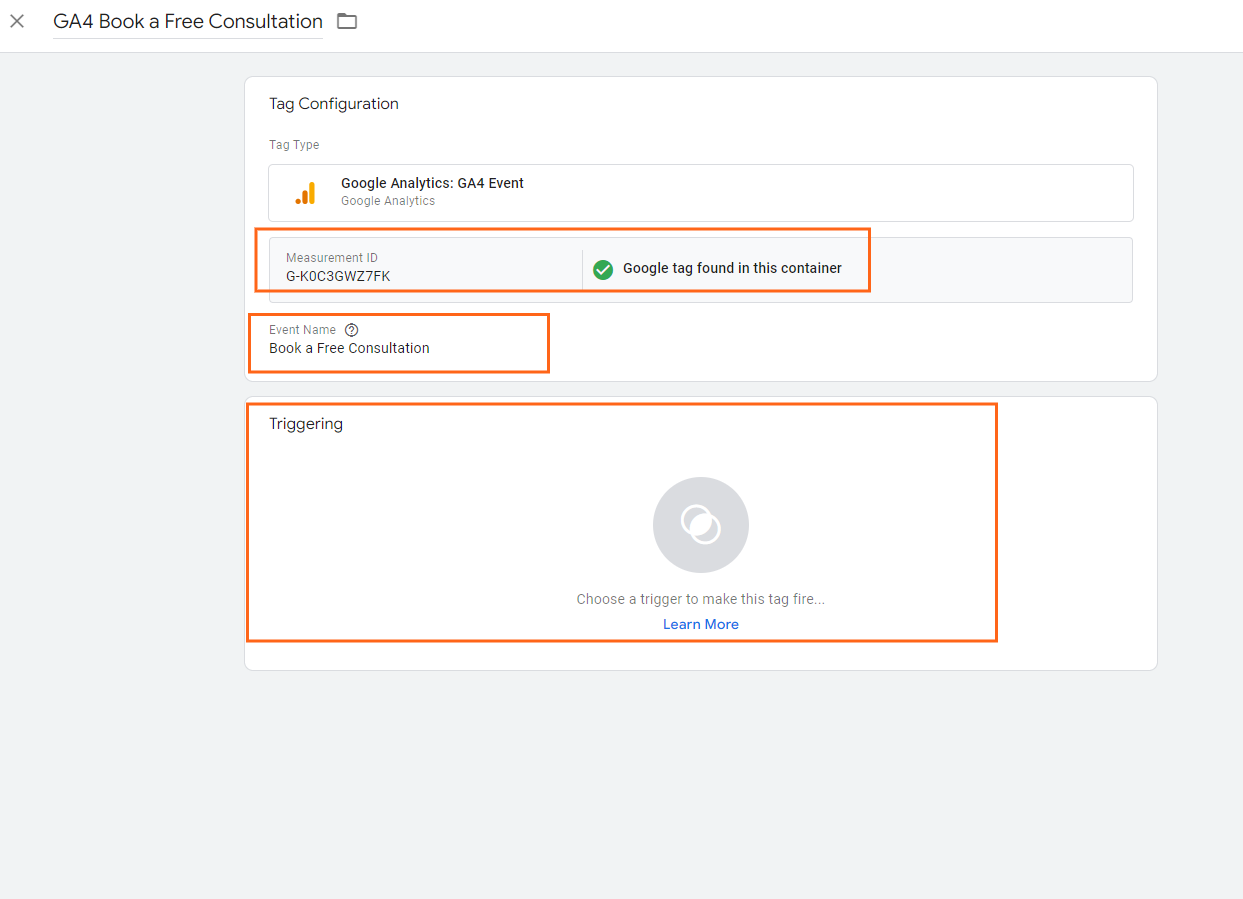
8. On the trigger creation page, same as the event, give your trigger a name. We’re using “Book a Free Consultation -trigger”. Click on the trigger configuration. Under Click, choose All Elements. The next part would be where we are going to use the Variable value that we got from the first section of this post.
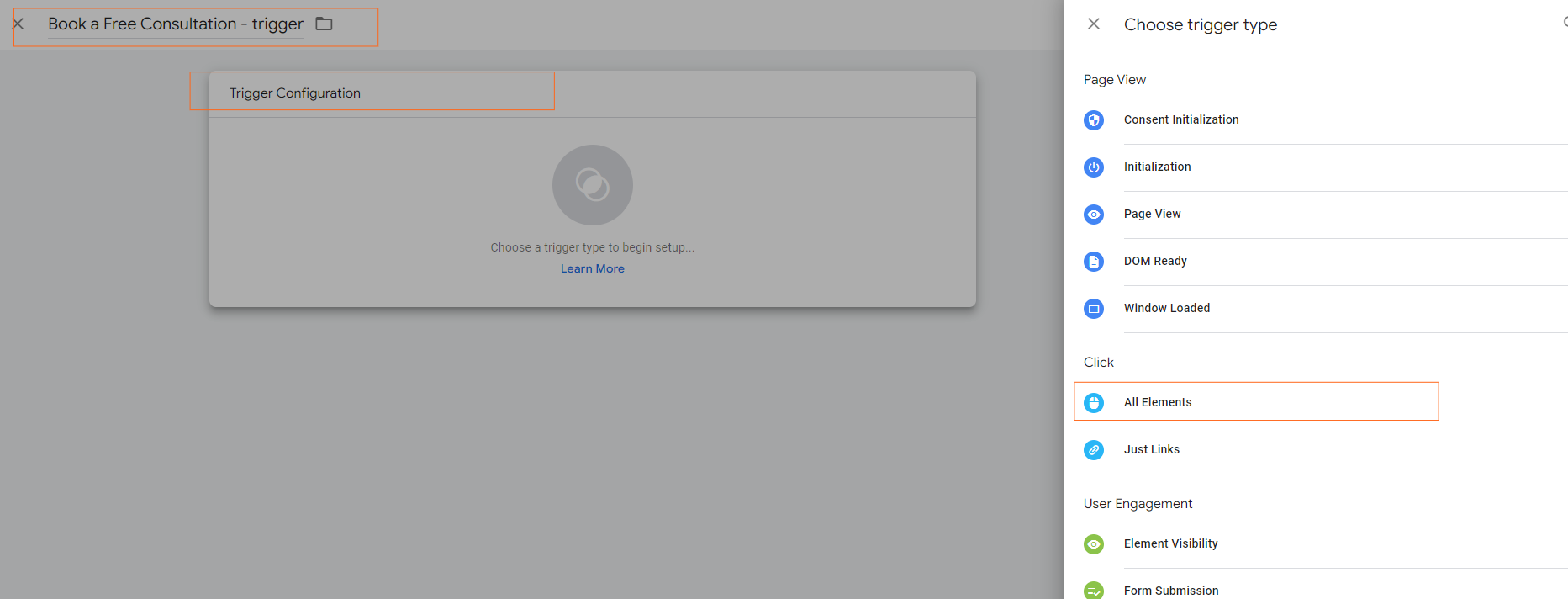
9. Click Some Clicks > Choose Click Text from the variable dropdown. Set the condition to contain the value “BOOK A FREE CONSULTATION” (without the quote). Then hit Save for both your newly created trigger and tag.

Now we are all set with the GA4 GTM event creation, the next thing we need to do is to test and confirm if it’s working.

Testing and debugging GA4 GTM Event
1. To test this, we need to follow the same procedure in the first section, from clicking the Preview button in GTM up until clicking the CTA button on your website.
But first we need to check if the newly created event tag is there…
2. In the Tagassistant page > Tags tab. Under the Tags Not Fired not fired section, the event should be there. If so, then you can try to click the CTA.

3. Once you’ve clicked the CTA, go back to the Tagassitant page and you should be able to see the interaction and under the Tags tab the event has been fired.
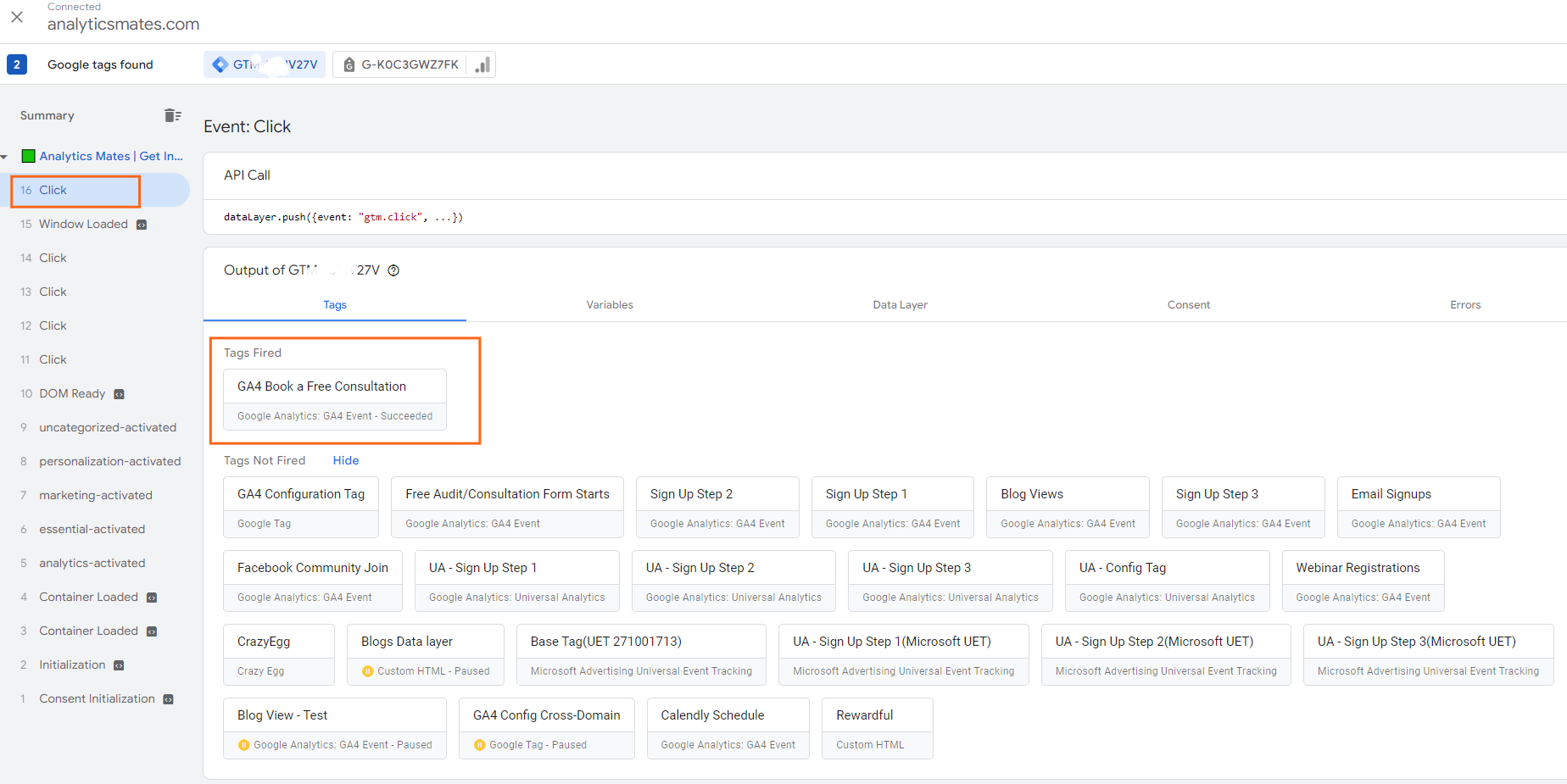
You can click the tag to view more details
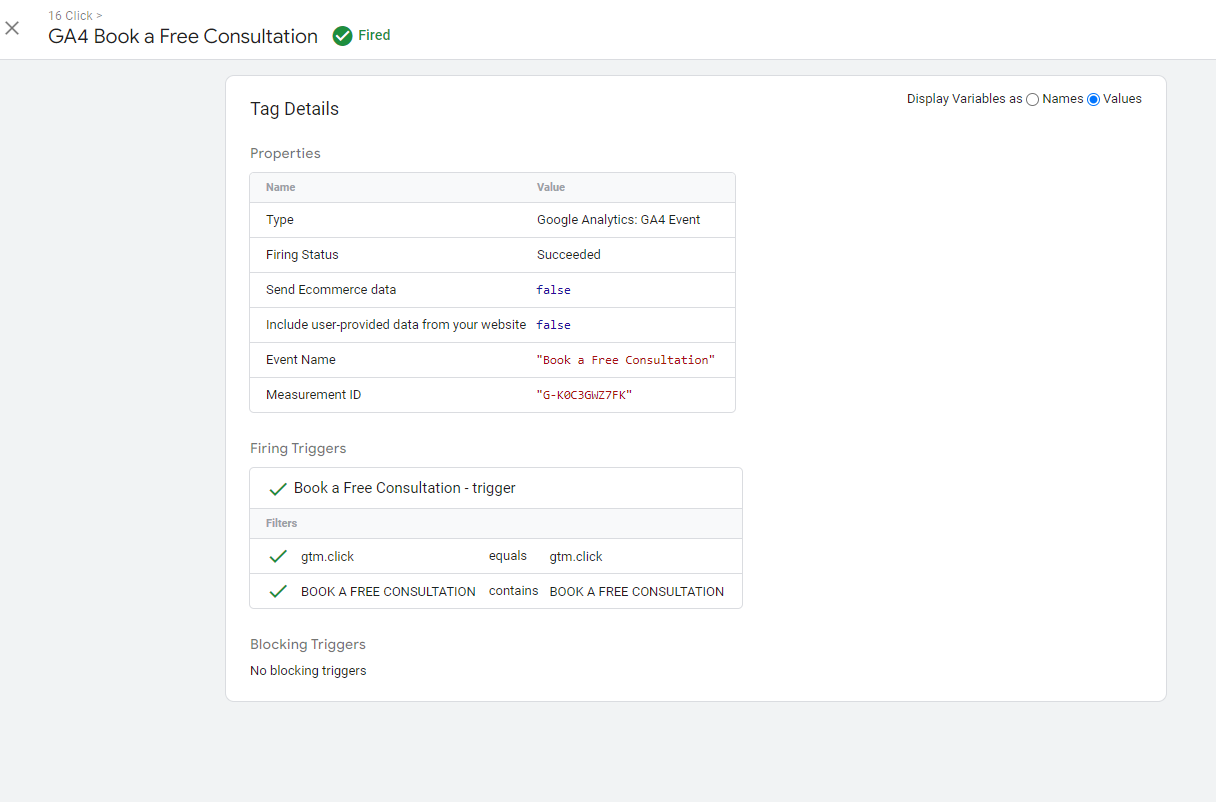
You should be all set, the data is passed onto your GA4. So the last thing that you need to do if you are already sure and if you want to track your CTA right away is to Publish the changes you made in GTM.
Publishing GA4 GTM Event
1. In your GTM account, at the top right corner of the page click Submit

2. You can add a Version name and also a brief description of your version and click Publish.
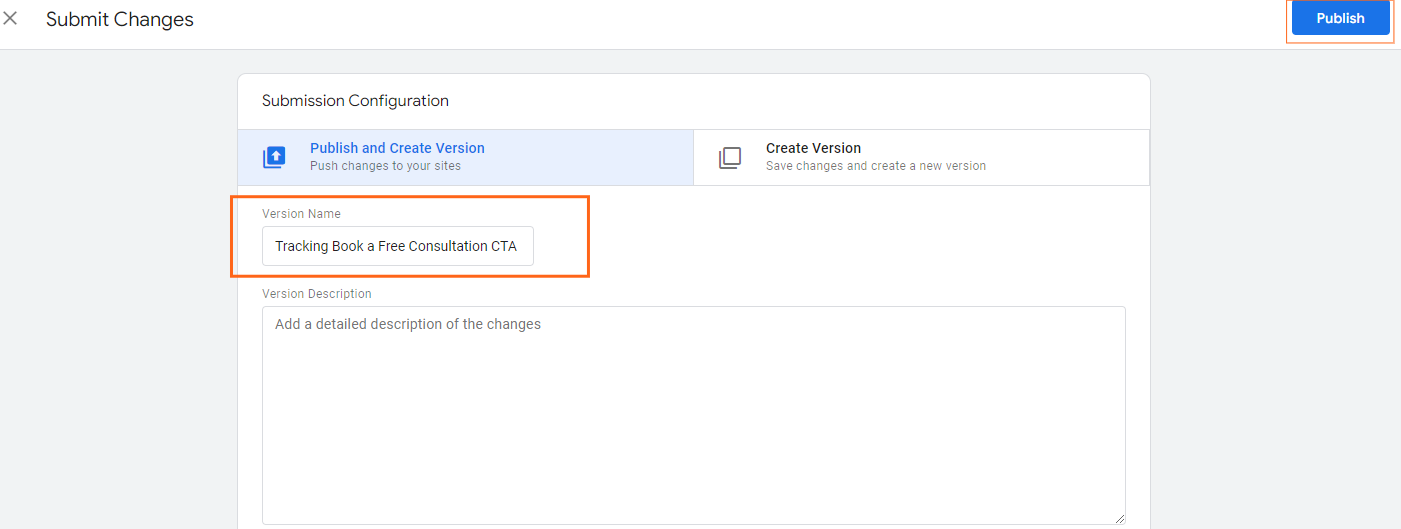
And there you have it! You're now equipped to apply this guide to track elements on your website effectively. Whether it's clicks, submissions, video plays, scrolls, custom events, or any other interaction, you can utilize these techniques. However, if you're seeking a more comprehensive approach to creating a GA4 GTM event tag using a data layer, we invite you to explore our detailed blog post on the topic. It provides in-depth insights and additional strategies to further enhance your tracking capabilities. Happy tracking!
How Will It Impact Your Google Ads Campaign?
Key events provide valuable insights for optimizing Google Ads campaigns. By tracking these conversions, you can refine ad targeting to reach users more likely to complete desired actions and adjust bidding strategies based on real-time data, ensuring efficient budget allocation and not wasting them down the drain. This approach enhances ad relevance and improves campaign performance by focusing on high-converting users.
Integrating key events with Google Ads further enhances Smart Bidding strategies, such as Target CPA or Target ROAS, by providing the data needed for more accurate automated bidding decisions. Proper event tracking also helps avoid attribution discrepancies across channels, ensuring conversions are correctly assigned and providing clear insights into marketing performance. Linking GA4 conversions to Google Ads allows for deeper performance analysis, enabling you to refine ad creatives, adjust targeting, and make data-driven decisions to optimize campaign outcomes.
How Does Conversion Impact Your Funnel Report?
GA4’s Funnel Exploration report offers a visual representation of how users navigate through your site or app, from the first interaction to the final conversion. It tracks specific steps users take, the time spent at each stage, and where they drop off, making it easier to understand user behavior and identify friction points. This clear visualization helps highlight the parts of the journey that need improvement to enhance the overall conversion process.

By analyzing the funnel, you can pinpoint where users abandon the journey before completing a conversion. For example, you might discover that users are dropping off after viewing a product page or at the payment stage. Once you identify these drop-off points, you can implement strategies to address them, such as simplifying the checkout process, improving product page details, or offering incentives like discounts to reduce abandonment and optimize conversion rates.
Defining key events within GA4 further enhances funnel analysis by giving you a more structured and detailed view of user actions at each stage. This enables you to make data-driven decisions on where to focus your optimization efforts. Real-world examples show how GA4 insights can help fix funnel leaks, such as improving site speed, refining product descriptions, or enhancing onboarding processes, ultimately improving user experience and boosting conversion rates. Well-defined key events ensure that your actions align with business goals and drive better results.
Best Practices in Creating a Key Event
We’ve covered most, if not all, of these points already, but it’s still helpful to summarize and save these insights for future reference. By doing so, you’ll have a valuable resource to refer back to, helping you avoid common pitfalls and streamline your process in the long run.
- Before implementing key events, it's crucial to understand your business goals. This will ensure that the events you track align with your objectives, such as increasing sales, improving user engagement, or optimizing website performance.
- Consistent naming conventions across all platforms help prevent confusion and errors when tracking events. For example, if you're tracking "Add to Cart" events, ensure the same naming convention is used in GA4, Google Tag Manager (GTM), and Google Ads to maintain alignment.
- Tracking the same event multiple times can skew your data. Make sure you’re not accidentally double-tracking key events, which can lead to overreporting and affect the accuracy of your data analysis.
- Before going live, use GA4’s DebugView and Google Tag Manager’s Tag Assistant to validate and troubleshoot event tracking. This ensures your events are firing correctly and that you’re capturing the right data.
- Event tracking isn’t a one-time task. Regularly review event performance and refine your tracking setup as your business goals evolve. Insights from data analysis can help optimize event configurations for better decision-making.
FAQs
Q1: What is the difference between key events and regular events in GA4?
A: Key events are the most important actions on your site or app that directly contribute to your business objectives (e.g., purchases, form submissions). Regular events, on the other hand, are tracked by GA4 automatically or are used for supplementary analysis, but may not be directly tied to business-critical outcomes.
Q2: How many conversions should I track in GA4?
A: The number of conversions to track should be based on your business goals. Focus on key actions that align with your objectives, such as sales, sign-ups, or downloads. It’s not about quantity, but about tracking the most meaningful interactions that impact your business.
Q3: Can I track key events without Google Tag Manager?
A: Yes, you can track key events directly in GA4 using the event setup tool or by implementing custom code on your site. However, using Google Tag Manager offers more flexibility and easier management, especially for non-technical users.
Q4: How long does it take for a conversion event to appear in Google Ads?
A: Conversion events from GA4 typically take 24 to 48 hours to show up in Google Ads, depending on data processing times. It's important to ensure proper integration between GA4 and Google Ads for seamless data transfer.
Q5: Why is my key event not showing in GA4 reports?
A: There are several potential reasons for this:
- Incorrect event setup: Double-check that the event is correctly configured in both GA4 and Google Tag Manager.
- Delay in data processing: It can take up to 24 hours for events to appear in reports.
- Event filtering: Ensure that your filters or segments are not excluding the key event.
- Tracking issues: Use GA4’s DebugView or Google Tag Assistant to verify the event is firing correctly on your website or app.
Q6: How do I know if a key event is important for tracking?
A: A key event is important if it aligns with your business objectives and helps measure success. For instance, events like completing a purchase, signing up for a newsletter, or downloading a resource are usually considered key because they represent critical user actions.
Q7: Can I modify or delete key events after they’ve been set up in GA4?
A: Yes, you can modify or delete key events in GA4. However, modifying events after they’ve been tracked may impact historical data. Always ensure that any changes are well-documented and properly communicated with your team.
Q8: Is it possible to track custom dimensions or parameters with key events?
A: Yes, GA4 allows you to track custom dimensions or parameters alongside your key events. This can provide more detailed insights into user behavior and interactions, such as tracking the specific products added to a cart or capturing the type of content viewed.
Q9: How do I track key events on mobile apps?
A: For mobile apps, you can track key events by integrating Firebase with GA4. Firebase automatically tracks some key events, but you can also configure custom events within your app’s code to capture additional interactions relevant to your business goals.
Q10: Can I use key events for remarketing in Google Ads?
A: Yes, key events can be used to create audiences for remarketing in Google Ads. By tracking important actions, you can build remarketing lists that target users based on their interactions with your site or app, improving ad relevance and conversion rates.
Final Word
GA4 Key event or conversion tracking is a fundamental aspect of analyzing your data and driving meaningful insights. It is important to have a clear understanding of your business goals and ensure that these objectives are fully aligned with the strategies you implement when setting up your key events. While it may seem complex at first, with proper planning and a structured approach, the process becomes much more manageable. By effectively tracking and interpreting key events, you can unlock valuable insights that will significantly improve your decision-making and help you achieve your business objectives with greater precision and efficiency.
Thank you for reading!
We're always looking for ways to improve our Google Analytics 4 blog content. Please share your feedback so we can make it even better.



%20in%20GA4%20and%20Avoid%20Costly%20Mistakes.webp)



%20Data%20in%20GA4.webp)





